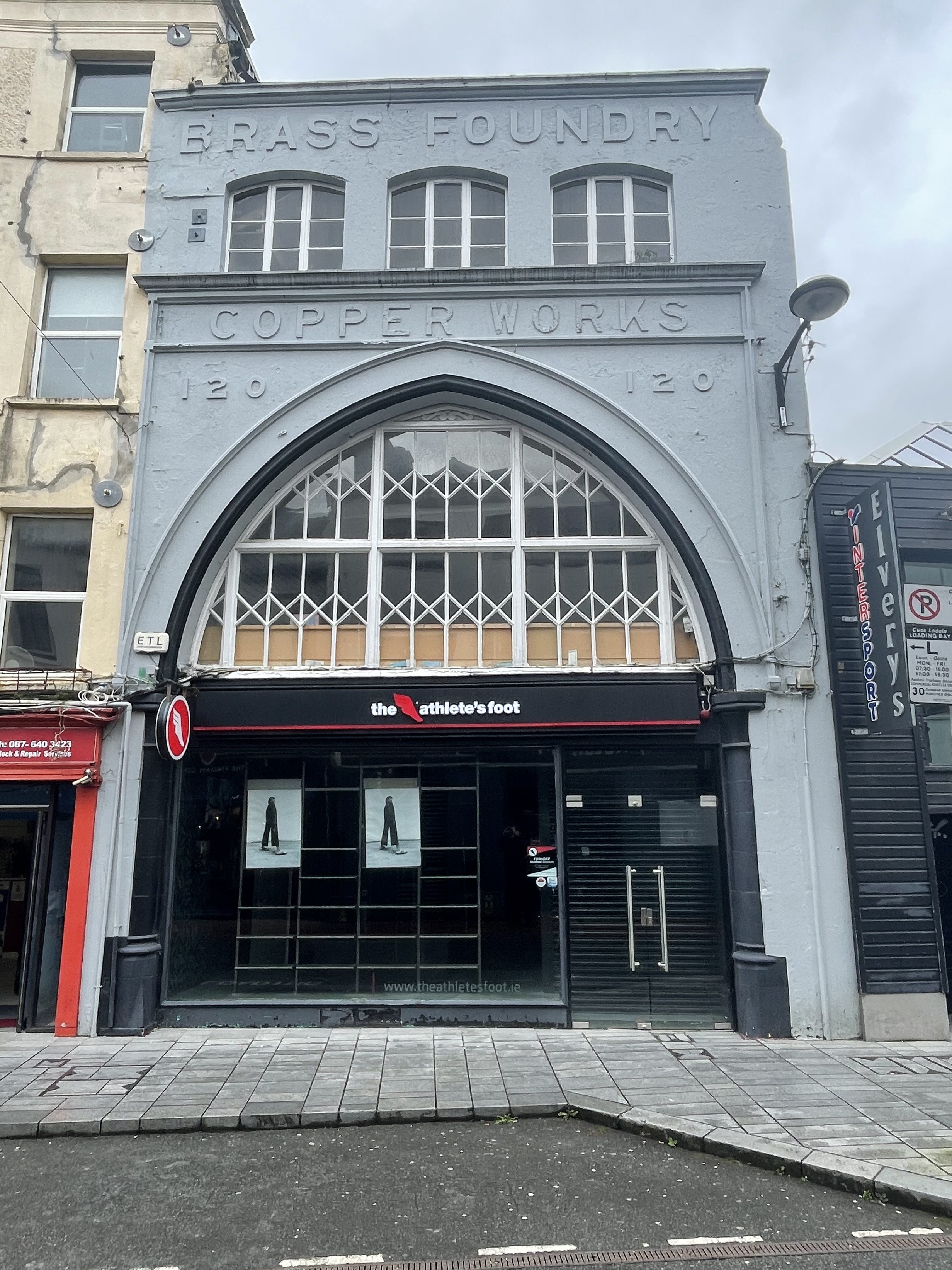Trail begins at the Berwick Fountain, Grand Parade or western Oliver Plunkett Street.
Introduction:
This history trail pages on Oliver Plunkett Street explores the historical development of the street from its beginnings in the early eighteenth century – the challenges posed by building on a marshland, a number of buildings of significance on the street, and also charts the history of some of the long-standing retailers synonymous with Oliver Plunkett Street.
In 2016, the street won the ‘Great Street Award’, awarded by London’s Academy of Urbanism.
Below is a brief historical walking trail, which covers some of the topics on my physical walking tour. The information is abstracted from various articles from my Our City, Our Town column in the Cork Independent, 1999-present day, Cork Independent Our City, Our Town Articles | Cork Heritage
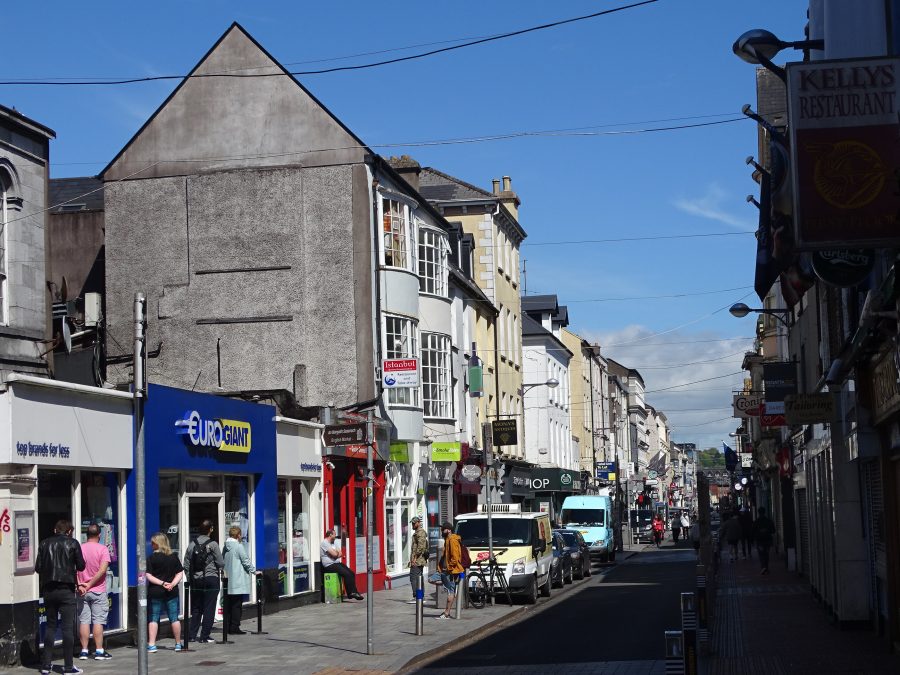
Grafton Alley:
In September 1690, the Earl of Marlborough along with a large contingent of men were despatched from England to take back the walled town of Cork from the Catholic supporters of James II for King William. On Monday, 22 September 1690, Marlborough arrived in Cork Harbour with over eighty ships with approximately five thousand men. A landing was opposed at Passage by Irish rebels, who possessed a battery of seven or eight cannons. These were soon squashed by several armed boats that were sent ashore to deal with this opposition.
On 23 September, the Marlboroughs’ troops disembarked onto land. A Colonel Hale brought a regiment of about 800 men from the ships, through the area of Douglas and encamped in the area of the Lough. A small contingent of Irish rebels attempted to block their passage but they were fired upon and killed. At an early stage, it was decided by Marlborough that the main defensive disadvantage of the walled area, its low-lying nature overlooked by hills should be exploited. To Marlborough, control of the hills along with the bombardment of cannon meant the rebels within walled town would have to surrender.
On 27 September, the bombardment of the city escalated. The cannons are said to have concentrated on breaching the eastern wall, now marked by the city library on the Grand Parade. It was perhaps during this foray that the Duke of Grafton was shot and killed on the eastern marsh. an illegitimate son of King Charles II. Henry FitzRoy – 1st Duke of Grafton was an illegitimate son of King Charles II. His intestines were buried in Ballintemple graveyard, while his body went back to England.

Within a number of days of the siege starting, the rebels within the walled town surrendered. There were several reasons for this. Large portions of the town walls, North and South Main Streets, laneways and houses were destroyed. The importance of the siege to Cork’s future lies in the fact that it was a major catalyst in initiating major changes in the physical and social landscape of the city in years to come – the start of taking the town wall down and further reclamation on other marshy island by the merchant community.
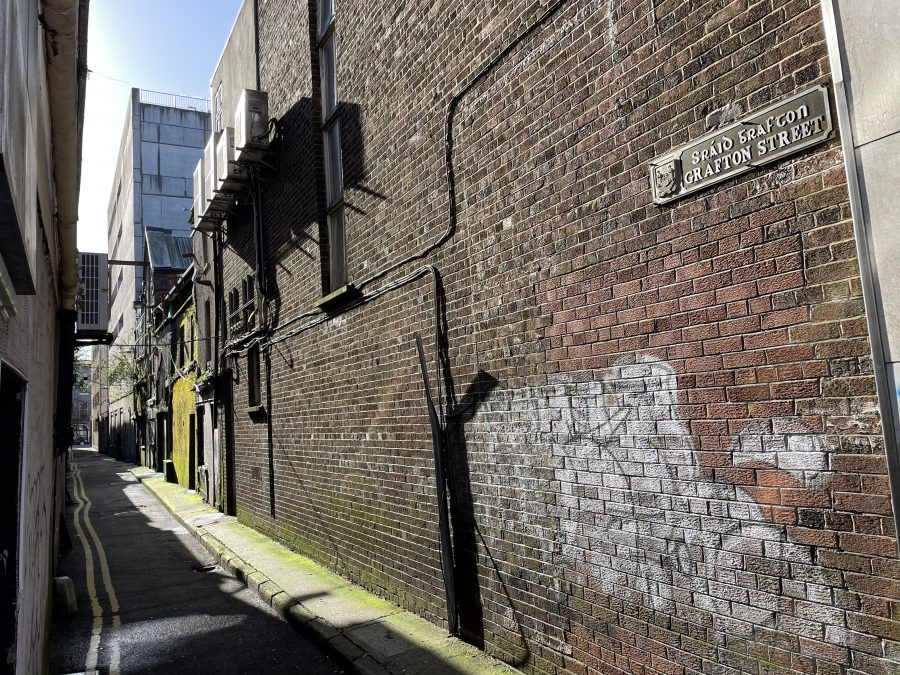
Tuckey’s Bridge:
Tuckey Family Lineage:
The damage from the Siege of Cork in 1690 was significant. Cork’s town walls lay heavily broken down and houses has been raised to the ground. The decision to take down the town walls and to leave the town to expand on expanding marshes was not taken likely and it was a process that took 50 years.
The Quaker family of Tuckeys led the way in the taking down of their south east town wall section. The first member of the Quaker Tuckey family arrived in Cork in the army of Oliver Cromwell. A leading figure in the parish of Christ Church, Timothy Tuckey Senior died in 1668, and was interred in a vault in the crypt of the Church. Tuckey’s son Timothy was elected Mayor of Cork in 1677, and it is after him the lane and subsequent street was named.
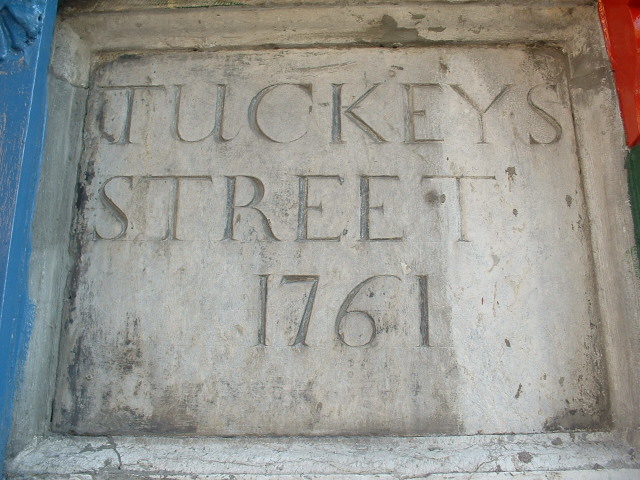
Tuckey’s Quay:
Circa 1694, Ormond’s Quay outside the town wall was leased to Alderman Timothy Tuckey for 99 years at a yearly rent of eleven shillings. It became formally known Tuckey’s Quay (now City Library section of the Grand Parade to Tuckey Street). A year later in 1695 Timothy Tuckey was given liberty to build houses on the Quay providing he left twenty feet clear in breath of the quay. Over the ensuing ten years, Timothy Tuckey also took down several sections of the town wall to its foundations.
Tuckey’s Bridge:
One particular and significant venture, which was recorded at length in Cork Corporation’s council books, was the agreement between Alderman Tuckey and the Dunscombe Quaker family in 1698. In mid-January 1698, Captain Dunscombe was given liberty to build a stone bridge from Tuckey’s quay onto his leased marsh. The Corporation of Cork required that the new bridge have arches high and broad enough for a small boat to pass under at high tide and must be kept in repair by the Dunscombe family and their heirs. Berwick Fountain is the exact site of Tuckey’s Bridge, which spanned a canal at that place, and on which the equestrian statue of George II was first erected.


Mapping the George’s Street Island:
Cork’s George’s Street was named to celebrate the ascendency of the German Royal House of Hanover to an English royal seat. Its first monarch came to the English throne in 1714. The western part of George’s Street was laid out across Cork’s unreclaimed eastern marshes from 1715 onwards and historic maps such as John Rocque’s in 1759 show that the street and its buildings in its eastern sections were still being developed.
In 1760, Mayor Thomas Newenham organised a subscription fund to erect an equestrian statue of George II on a pedestal on a specially constructed arch at the western entrance to George’s Street on the south side of the eminently arched Tuckey’s Bridge (centre of present day Grand Parade and marked by Berwick Fountain). In late September 1760, it was further decided to enlarge this bridge so that carriages could pass on each side of statue into George’s Street.
Very little survives on the present day street from the early eighteenth century but there are some very fine examples of Georgian architecture from the late eighteenth century and early nineteenth century.
The side streets of Georges Street were named after prominent Protestant merchant figures.
Such names added to British imperial remembering structures within the city.
- John Churchill, Duke of Marlborough
- Stephen Cook, Sheriff of Cork in 1681
- William Winthrop, Sheriff of Cork in 1741 and Mayor in 1744
- Thomas Pembroke, Sheriff of Cork in 1724 and Mayor of Cork in 1733
- Samuel Maylor, Sheriff of Cork in 1766
- Caroline Street is named after Queen Caroline of Brunswick, wife of George IV.
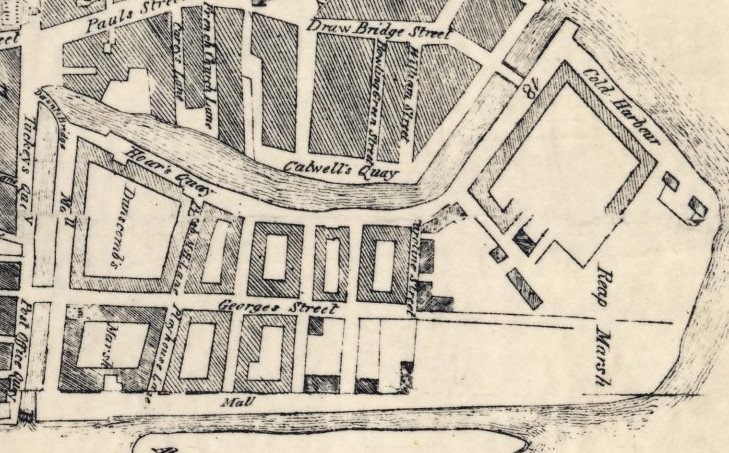
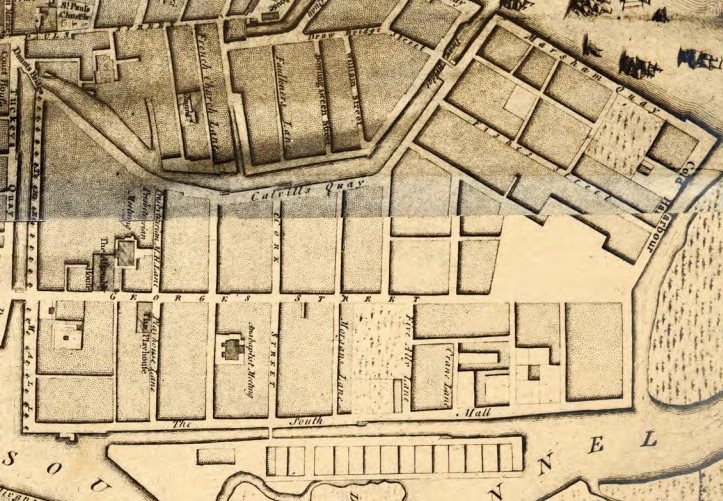

Exploring the Architecture of Georges Street:
For a 300-year old street, many buildings survive from the late eighteenth century and early eighteenth century. There is also some very beautiful late nineteenth century architectural specimens. Evidence of renovation and regeneration is present throughout the street and its side streets but for the most part buildings have been tastefully restored. Below is an array of some the most elegant architectural pieces on the street.

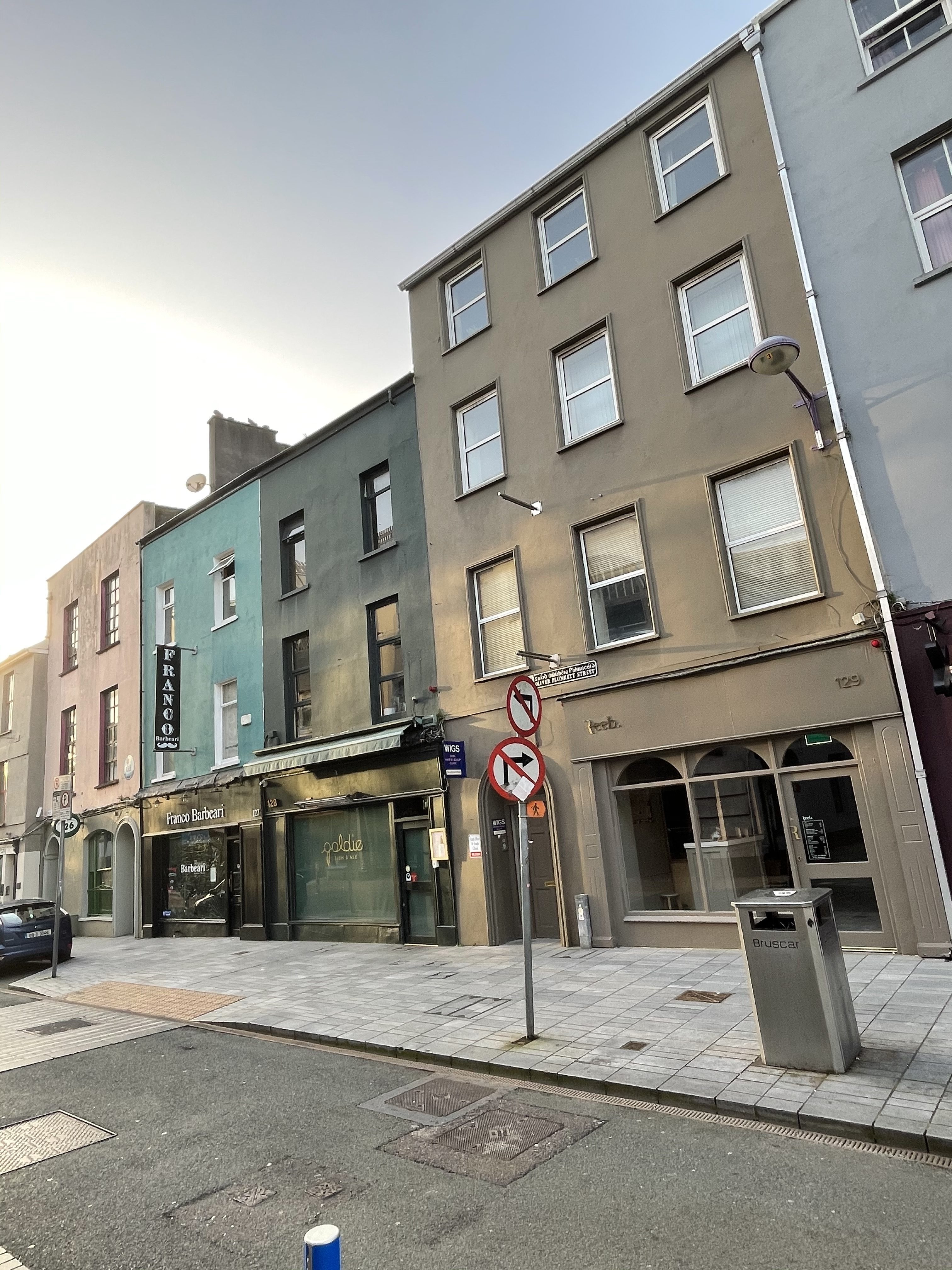
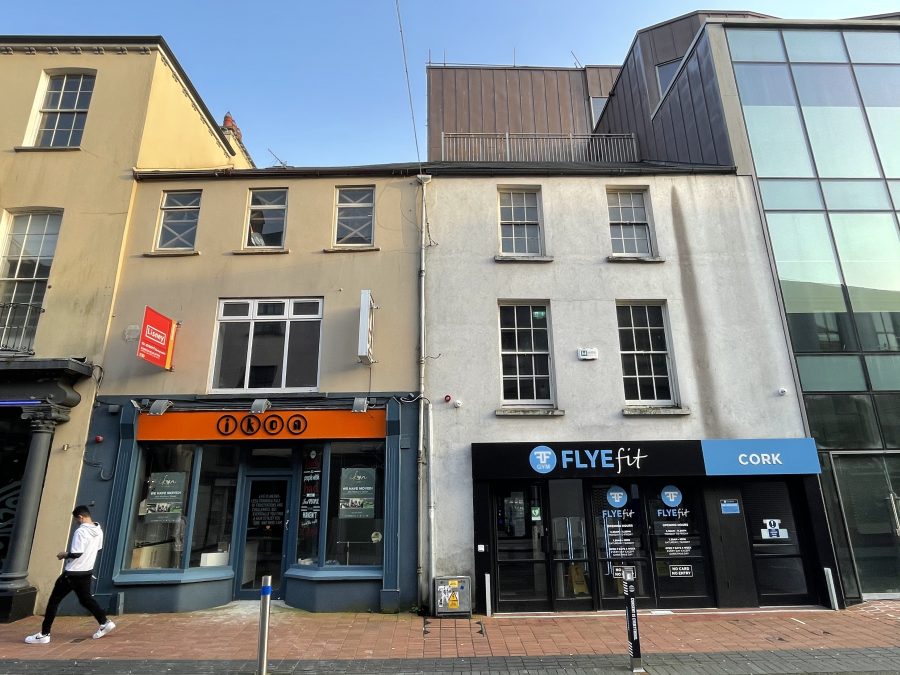

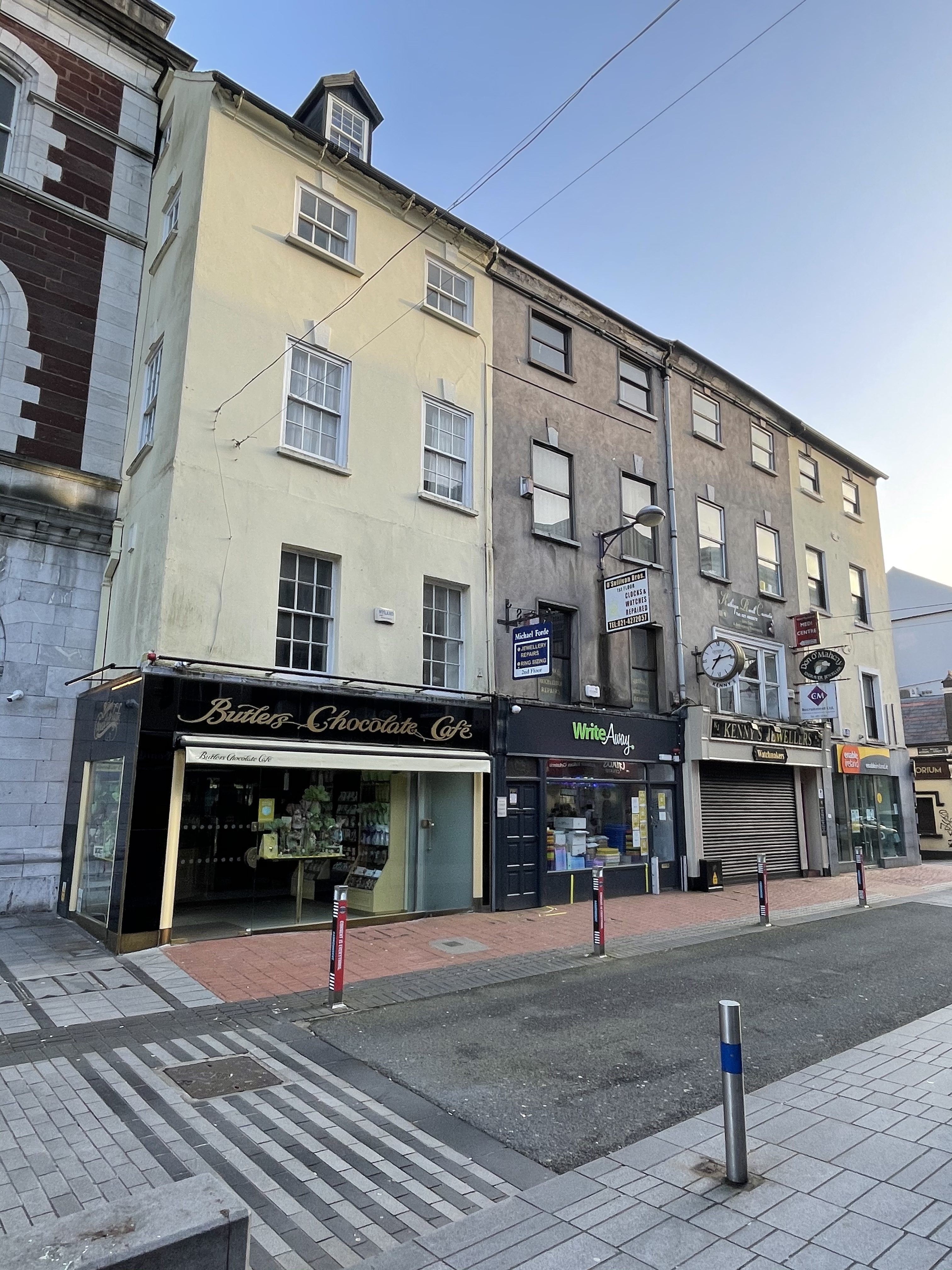
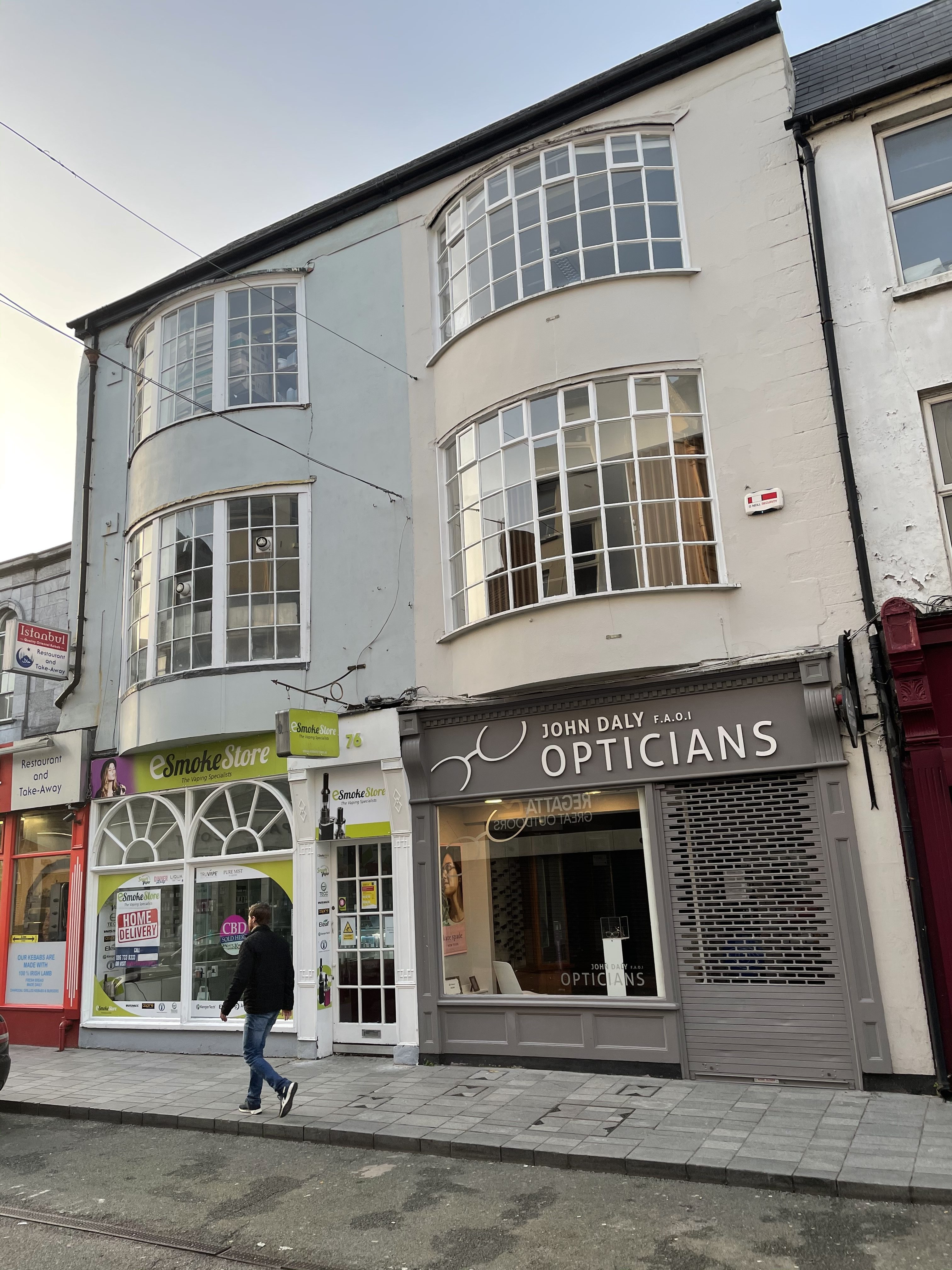
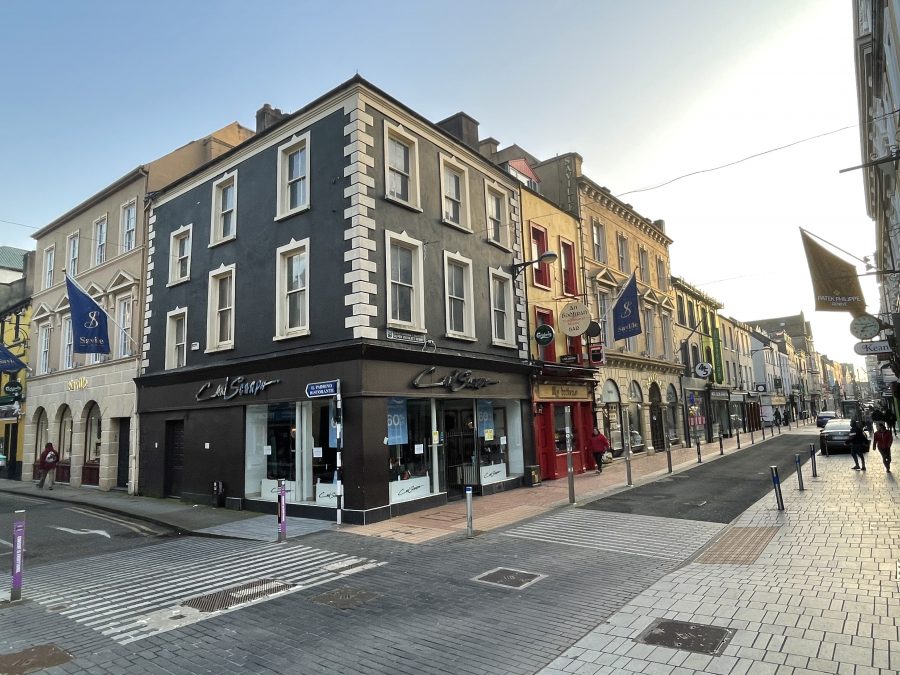
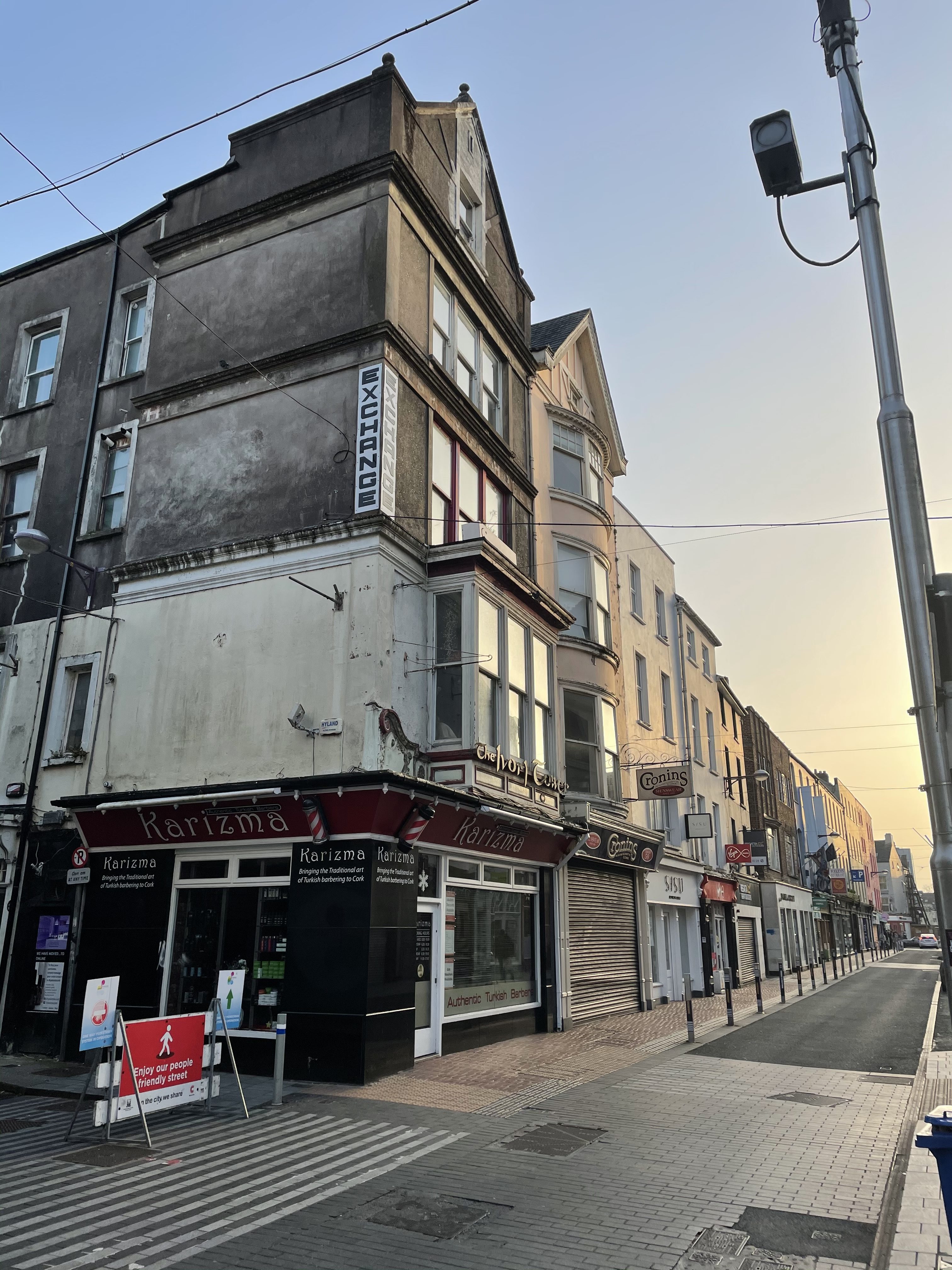
Naming Oliver Plunkett Street, 1920:
At the meeting of Council of Cork Corporation on 14 May 1920, Lord Mayor Terence MacSwiney presided. On the agenda was a discussion on the beatification of Oliver Plunkett headed up by Sinn Féin councillors. A number of decisions arose out of it. One of the principal ones was the proposal by Cllr Micheal O’Cuill that the name or George’s Street be changed to that of Sráid Olibhéir Phluingcéid (Oliver Plunkett street), and this was seconded by Cllr Seán O’Leary and passed unanimously. This change in name just came within a month of the change from (Robert) King Street to (Tomás) MacCurtain Street.
Renaming streets was a very symbolic act and another mechanism to breaking bonds with the British Empire. The name Oliver Plunkett (1625-1681) is a far cry from the connections with the House of Hanover. Temporally he did not live in the eighteenth century and is linked to martyrdom and suppression. He was an ideal candidate to commemorate during the Irish War of Independence. Oliver was born at Loughcrew, near Old Castle, Co. Meath in 1625. Up to the age of sixteen he was educated by Dr Patrick Plunkett, Abbot of St Mary’s Dublin. Subsequently he studied for the priesthood at the Irish College, Rome.
Oliver was ordained in 1654 and acted as agent in Rome for the Irish Bishops. In 1669 he was appointed to the Archbishopric of Armagh. In 1670 be returned to Ireland and established a Jesuit College in Drogheda in 1670. In 1679 he was arrested on a charge of high treason, which was supported by the evidence of witnesses who came forward to prove a Popish or Roman Catholic plot to kill England’s King Charles II. The King did not believe in the conspiracy and refused to get involved in the case of Oliver, and the law was allowed to take its course.
Brought to Westminster before an all Protestant jury, during the first trial, Oliver disputed the right of the court to try him in England. He was found to have pursued no crime but was not released. During the second trial, he drew focus on the criminal background of some of the witnesses, but to no avail. Found guilty Oliver was hanged, drawn, and quartered at Tyburn on 1 July 1681, aged 55. He was the last Catholic martyr to die in England. His story of a miscarriage of justice was not forgotten about in and was harnessed in many subsequent debates from condemning the Penal Laws to calling for Catholic Emancipation in the early nineteenth century.

Fast forward to 1920 nationally the story of the miscarriage of justice of Oliver Plunkett was connected to the war for Independence and in a Cork context to the murder of Tomás MacCurtain and his ongoing memorialisation. The Cork Examiner records that at the Cork Corporation Council meeting of 14 May 1920 this latter connection is seen through Sinn Féin’s Cllr Professor Alfred O’Rahilly, who proposed: “We, the Corporation of Cork, in Council assembled, hereby record the joy and satisfaction of the people of Ireland at the approaching Beatification of the Venerable Oliver Plunkett, the martyred Archbishop of Armagh, who 239 years ago, as the victim of a bogus plot, was seized and deported by the English Forces then in Ireland, and was legally murdered as a criminal and a traitor. We direct that this resolution be forwarded to the Cardinal Secretary of State, to his Eminence Cardinal Logue, to his Grace Dr Harty, Archbishop of Cashel, and to his Lordship Dr Cohalan, Bishop of Cork”.
Cork and the Beautification of Oliver Plunkett, 1920:
To mark the Beatification of Oliver Plunkett in Rome on 14 May 1920, Bishop Cohalan celebrated high mass at the North Cathedral where Lord Mayor MacSwiney and councillors were present. In all the churches of the city after Mass at noon the Blessed Sacrament was exposed on the High Altar.
Twenty-four hours previously, the Lord Mayor sent out a public call to citizens to illuminate their houses and display flags and bunting to commemorate the historic and holy event. Mass pageantry ensued. On 14 May 1920 rows of houses in whole streets were all lit up. Statues and pictorial representations of the Sacred Heart were erected inside the windows and surrounded by vari-coloured lights, the Papal colours – gold and white – predominated. The Papal Flag was displayed from very many homes. The Sinn Féin flag flew over public buildings, such as the City Hall, the Markets, and was also hoisted over the Courthouse in Washington Street. The latter flag was put up in the morning by some young men with the aid of the fire escape outside the Court House.
A demonstration was made in the evening by the members of the Irish Trades and General Workers Union whose hall at Camden Quay was beautifully decorated. Accompanied by the Connolly Memorial Fife and Drum Band, the Union members of well over one thousand left the hall and proceeded to Blackpool Bridge. Here a halt was made to pay tribute to the memory of the late Lord Mayor, Alderman Tomás MacCurtain. The band played outside his residence for some time.
The processionists then went to the Cathedral, outside which the band played, and having paid a similar visit to the Church of the Franciscans. Liberty Street, they marched onto the National Monument on the Grand Parade. Here Rev Fr Mathew OFM, said the rosary in Irish with the crowd kneeling and giving responses to the Rosary. The band and members then went on to the Holy Trinity Church, and having halted outside it and played, a return was made to the hall, Camden Quay.
At Cork City Hall the facade over the main entrance was lined with electric bulbs, and in the centre was placed a shamrock, the bulbs being coloured gold and white. At some points of the city tar barrels were set ablaze. The illuminations continued to midnight. All of this happened as Black and Tans loomed more and more in making their presence felt.
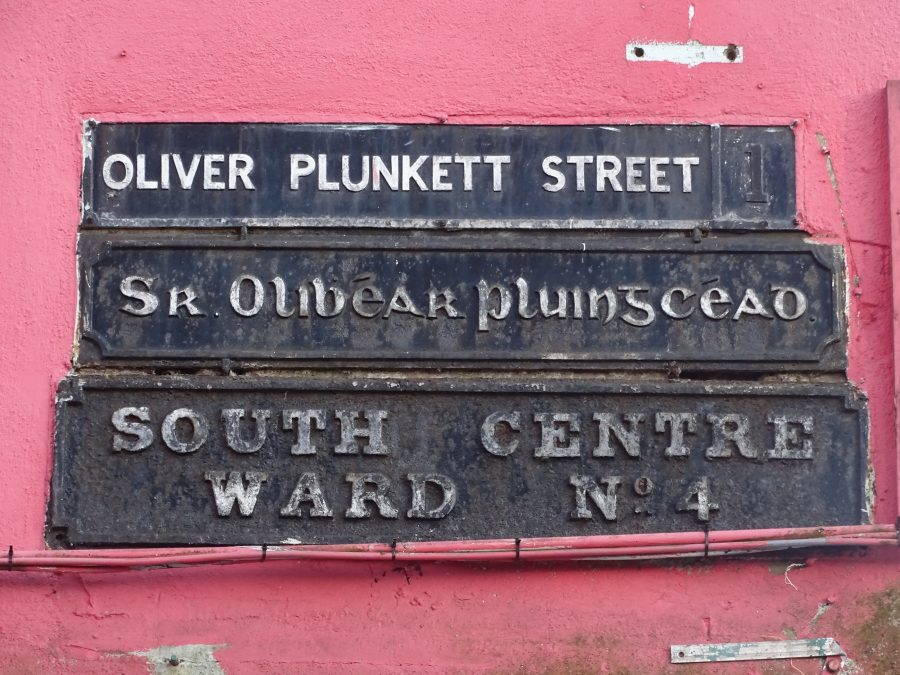


Playhouse Lane:
The first reference to a theatre in eighteenth century Cork occurred in 1713 when the directors of Smock Alley Theatre Dublin, Messrs. Joseph Ashbury, Thomas Elrington, John Evans, Thomas Griffith leased property in the marshes to the east of the walled town, now the area of Oliver Plunkett Street. The directors converted a large room into a playhouse. This was the first Smock Alley Theatre outside Dublin. The associated company of actors of the Smock Alley Theatre performed there for two decades during the summer months and entertained the masses of Cork’s population. At the beginning of the decade of the 1730s, a decision was taken by directors of the Cork Theatre to design a new and proper playhouse. This was to be more suited to the needs of performers and audience. Funds to construct the new Cork Theatre came from the estate of Thomas Elrington who died in Dublin in 1732.
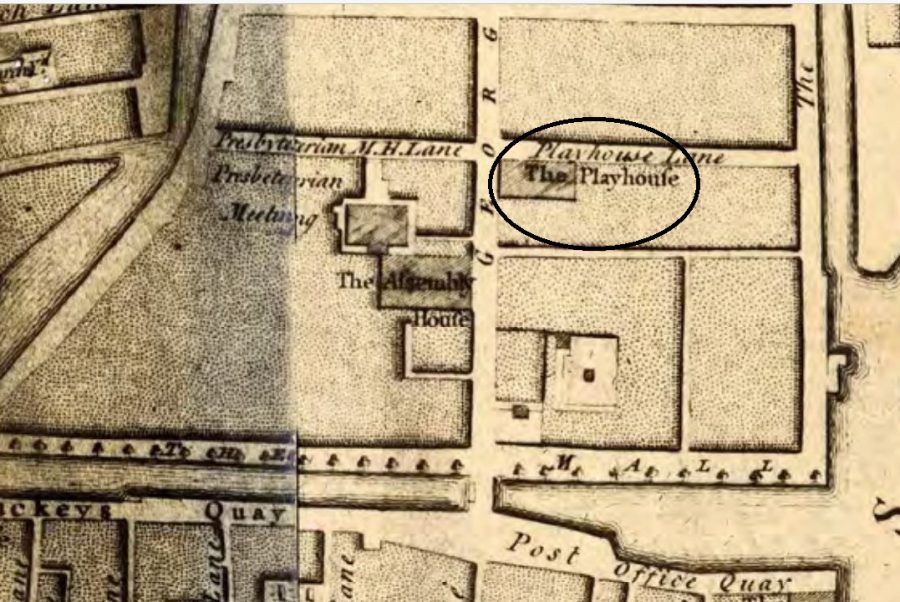
With increasing wealth and elegance came a proposal in 1759 by the management of the Crow Street Theatre Dublin, headed by Spranger Barry, to create a playhouse more fitting of Ireland’s second city. The new building was located three blocks east of the old Theatre Royal on the same side of George’s Street between Morgan’s Lane (now Morgan Street) and Five Alley Lane (now Pembroke Street). The Cork General Post Office now occupies the site. The playhouse façade on George’s Street possessed a ground floor arcade or a façade similar to that of the Crow Street. The new playhouse finished in early summer 1760, 136 feet long and 60 feet wide,
The Cork playhouse was the biggest playhouse in eighteenth century Ireland outside Dublin. In the intervening periods of uncertainty in the eighteenth century, the Theatre Royal was subject to great competition, all of which did not last the test of time and many closed within a decade, a number of small actor companies established new playhouse venues in Cork’s expanding urban area.

A fire gutted the Theatre Royal in 1840, but it was reopened in 1853. In 1875, owner, James Scanlan sold the Cork Theatre Royal on Oliver Plunkett Street to the Postal authorities who were to use the building as the city’s General Post Office.
On 10t April 1875, the last three professional performances that were to take place in the Theatre Royal were announced in the Cork Examiner. These performances comprised; Monday 11th Virginius; Tuesday 12th, Hamlet; Wednesday, 13th, Belpheggar. After a period of 113 years, from 1760 to 1875 (Cork Theatre Royal), James Scanlan shifted the centre of theatrical interest to a building at the side of the northern branch of the river Lee, which had been variously known as the Athenaeum, the city’s arts venue.
Princes Street & The Unitarian Church:
The Prince’s Street Unitarian Church was built between 1710-1717 as a Presbyterian meeting house and today is home to Cork’s Unitarian Congregation.
This church is recorded as the oldest place of worship in the city. It was built to replace an earlier meeting house at Watergate Lane in the medieval town, which has become too small for the congregation. It was one of the first structures built outside the medieval city walls on the eastern marshes. The site for the new church was found in the aid out streets of the expanding city.
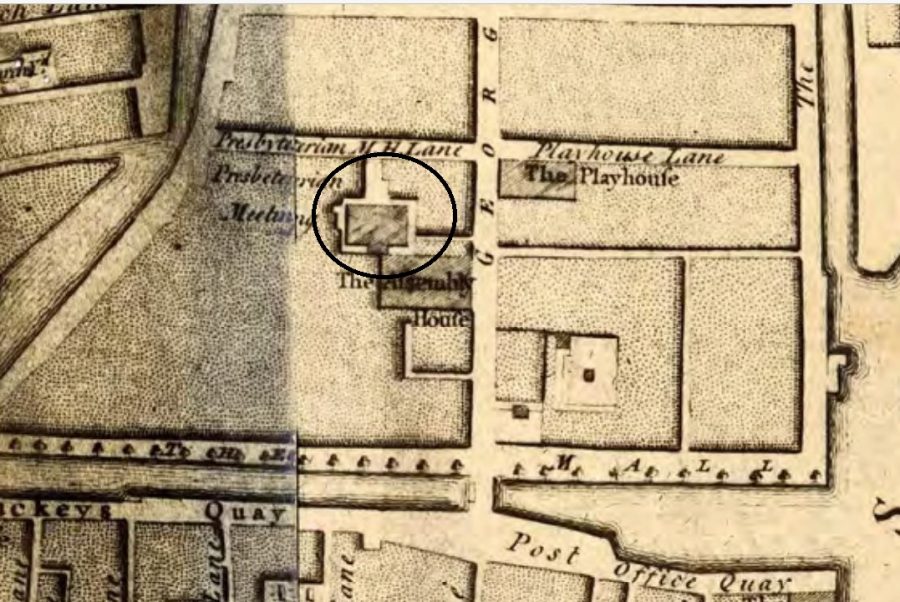
The plan and lay out differs substantially from contemporary churches of the Roman Catholic, Church of Ireland and Presbyterian traditions in the city. The interior is essentially square, surrounded on three sides on both ground and gallery levels by congregation seating. It is an auditory church, designed to allow the congregation to hear the preacher or clergyman, rather than follow a service at a distance. Still in its original use, the building is a significant contributor to the social and architectural heritage.
Some of its distinguished parishioners include Rev T D Hincks, founder of the Royal Cork Institution (precursor to Cork Institute of Technology), artist Daniel MacAlise, and Lord Mayor Richard Dowden. The Father Mathew Temperance Agreement was signed in this church in 1839.
FIND OUT MORE: UNITARIAN CHURCH CORK PRINCE’S STREET CORK FOUNDED 1717 – Unitarian Church Cork – A Liberal Inclusive Place of Worship

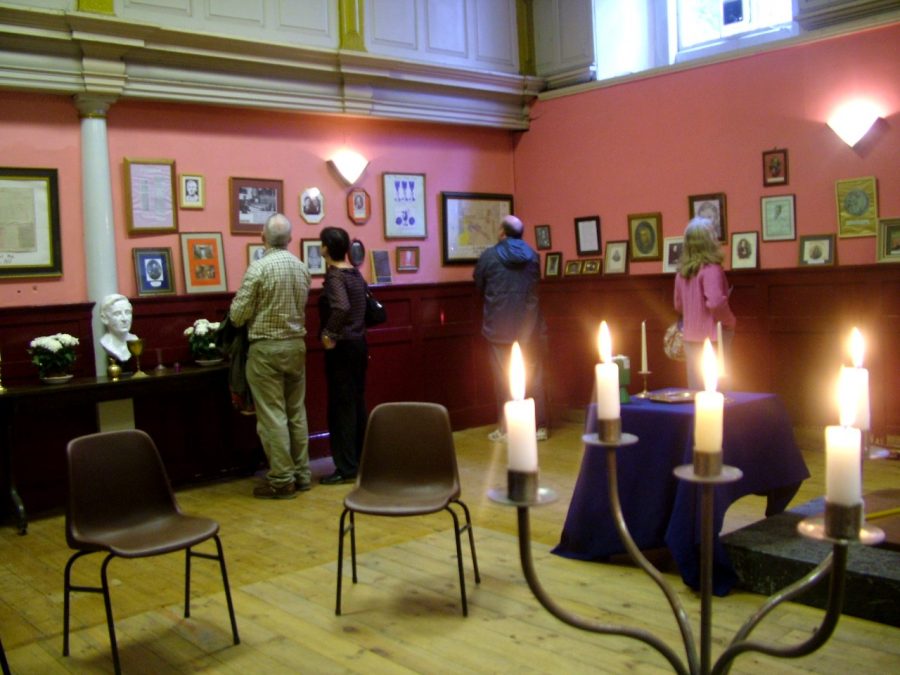
Princes Street and Pedestrianisation:
In 1971 Princes Street, one of the busiest shopping thoroughfares in Cork was to become the first pedestrian only street in Ireland.
Lord Mayor Peter Barry TD told RTÉ News about the pedestrianisation and what it will mean for traders in the area. Peter Barry also believes that this is just the beginning of a number of pedestrian only streets in Cork.
View the RTÉ News report broadcast on 1 March 1971:RTÉ Archives | Environment | Pedestrianisation Of Princes Street (rte.ie)
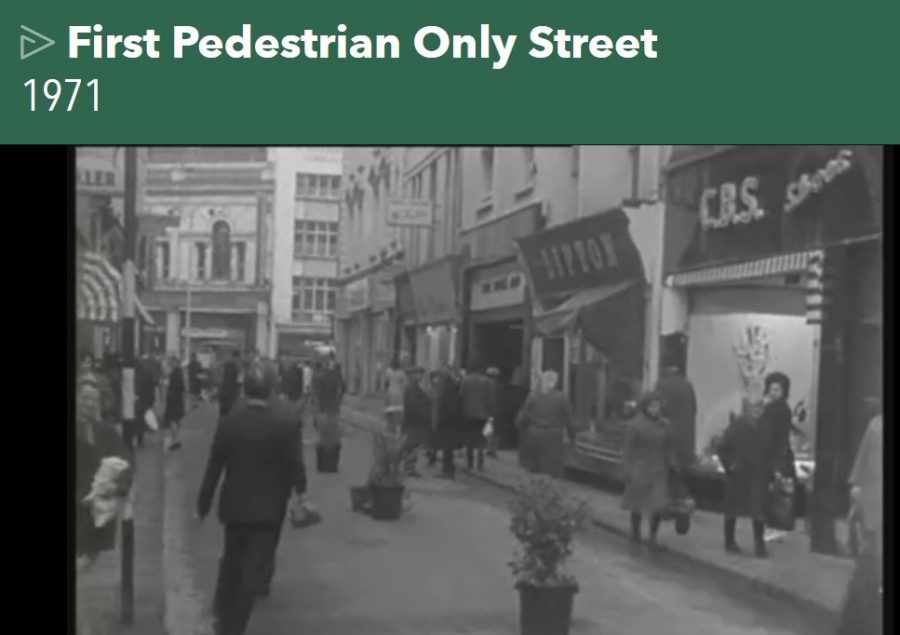
VIEW Kieran’s The Architecture of Princes Street, Cork:
Independent Chapel:
Hidden behind Euro Giant retail shop is the former five-bay two-storey independent chapel. In the early eighteenth century, it was an assembly house of the Protestant merchant class on the newly reclaimed eastern island.
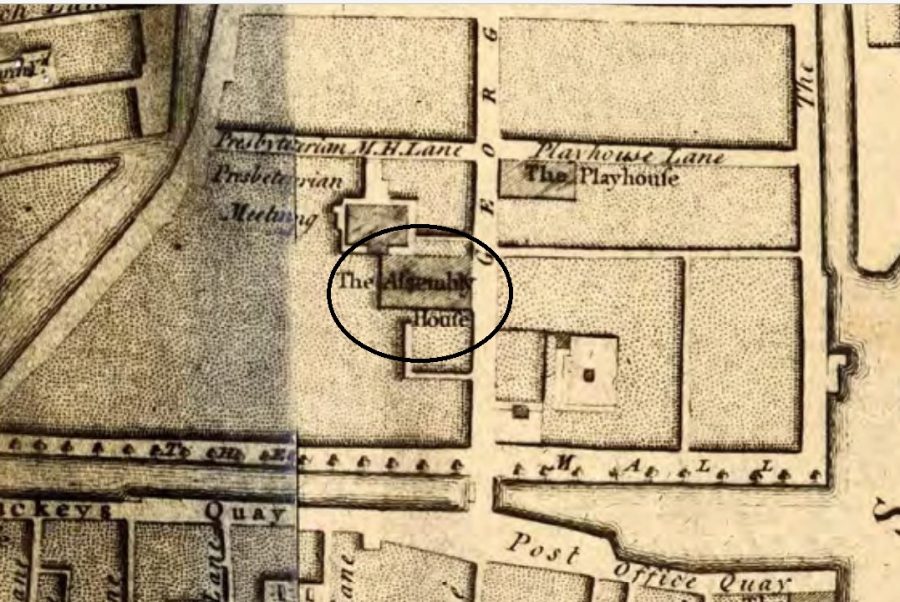
A century after its construction the structure was rebuilt c. 1829 and designed by George Pain as Independent Chapel. George Richard Pain of Cork is mentioned as being responsible for the churches at Mitchelstown, Midleton and Macroom. But, in Cork cityalone he did St. Luke’s Church, St. Patrick’s, Holy Trinity Church, Fr. Mathew Quay, re-constructed the: North Cathedral and deisgned the Independent: Chapel at Princes Street, as well as the Church of Ireland churches at Buttevant, Carrigaline and Castlehide. He died in 1838 at the early age of forty-five years.
The Independent Chapel was also remodelled in 1876 by architect William Hill.
Sometime in the early 1920s the building was discontinued its function as a place of worship and became a motor showroom for CAB Motor Show Rooms. In addition, the plaza in front of it fronting Oliver Plunkett was filled in by retail stores.
CAB Company were the authorised Ford dealers for Cork, and their showrooms, into which they converted their premises, provided opportunities for the display of the latest Ford, Fordson, and Lincoln models. CAB left about 1945 and the premises had a number of businesses ranging from those selling agricultural implements to furniture. It is now the premises of Euro Giant.
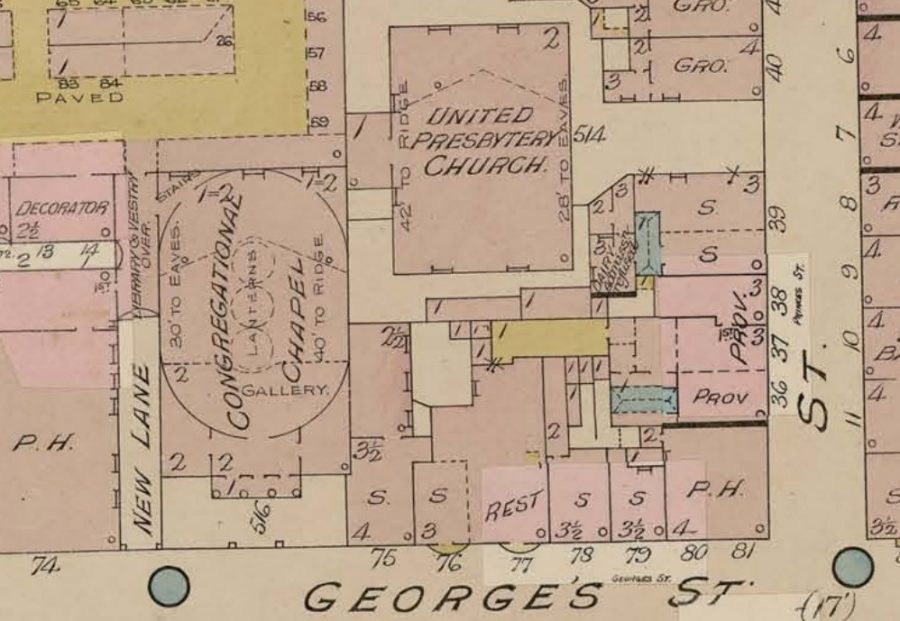



Liam Ruiséal’s Bookshop:
For many decades, Liam Ruiséal’s bookshop was a famous premises on Oliver Plunkett Street.
In 1916, Liam Ruiséal started his own shop, “The Fountain Bookshop,” in the Grand Parade and after three years as manager of Browne & Nolans, Cork (from 1926 to 1929), he again went into business for himself in Oliver Plunket Street.
It was appropriate indeed that his first shop should have had its beginning in the year of the Rising, in which he played a part, His first ledger of 1916 bore the names of many who were prominent in the fight for Irish freedom, all of whom were personal friends of Mr. Russell. Indeed, his place of business at the Grand Parade became the rendezvous for Ireland’s freedom fighters and the subject of much attention by the British authorities.

From his very early days, Liam Ruiséal was interested in the Irish Republican Movement. He joined the Gaelic League as a boy in 1907 and six years later enlisted in the Volunteers.
At a time when he was launching his own business in 1916 he found time to take part in the famous march to Macroom and in April. 1916. to take part in the Rising.
Liam was elected to Cork Corporation as a Sinn Fein councillor in 1920 and supported the election of Tomas MacCurtain and afterwards that of Terence MacSwiney as Lord Mayors of Cork. He was present in London and Brixton Prison for the funeral of Lord Mayor MacSweeney.
Liam had many escapes when his premises in the Grand Parade were raided and was one who eluded the British Military in Cork Courthouse in January, 1921 at the election of Mr Donal Og O’Callaghan as Lord Mayor. The Council chamber and Courthouse was surrounded by soldiers. He retired from public life in June, 1924, and has since been engaged in social work. But he is a man of many parts. He was as one time chairman of the Booksellers’ Association of Great Britain and Ireland (Irish branch) and is a past member of the governing body of UCC.
In the 1920s, he was cofounder of the Oliver Plunkett Street Traders’ Association, out of which grew the Cork Business Publicity Association.
The Oliver Plunkett Shop was expanded to take in an adjacent premises in 1967.
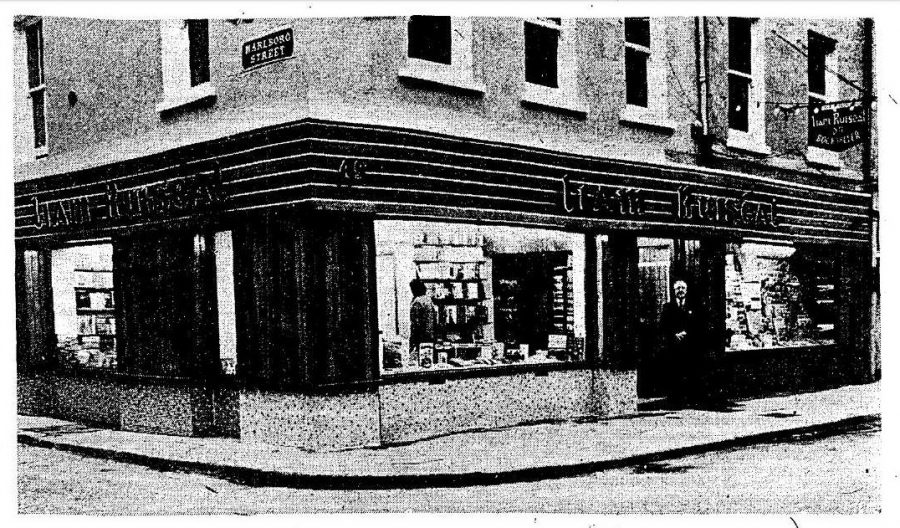
Liam Ruiséal worked in the bookshop until three weeks before his death on October 26, 1978, aged 87. He is buried in St Joseph’s Cemetery.
Liam Ruiséal’s bookshop closed in 2018.
READ MORE HERE: Liam Ruiséal bookshop celebrates 100 years in business by Eoin English, Liam Ruiséal bookshop celebrates 100 years in business (irishexaminer.com)
READ MORE HERE: Cork’s oldest bookshop Liam Ruiséal’s to close by Grainne McGuinness & David Linnane,Cork’s oldest bookshop Liam Ruiséal’s to close (echolive.ie)
READ MORE HERE: Recession and competition caused closure of iconic Liam Ruiséal’s by Eoin English, Recession and competition caused closure of iconic Liam Ruiséal’s (irishexaminer.com)
Marlboro Street & The YMCA:
The YMCA societies were founded across Ireland from 1849 onwards and were the brainchild of Revered Dean O’Brien. By 1894, the one in Cork was the only one that remained. In other towns and cities once flourishing societies became split up, and gradually disappeared, their places being taken by other associations.
Cork Merchant John Charles Newsom campaigned for a new building and merchants like him contributed generously towards one on Marlboro Street. On 2 March 1894, a gorgeous and spacious red brick building opened. Designed by architect William Henry Hill, it was built by John Delaney and his team. The Cork Examiner, the day after the event recorded that on the ground floor there was lecture hall, at the southern end. On the first storey was a reading room, secretary’s office, retiring room, and junior members’ room. On the second storey was situated a classroom for educational purposes and rooms for the committee, honorary secretary, and caretaker. On the top storey was the gymnasium. The entire cost of construction has been about £5,000, £850 of which was expended in purchasing the ground and chapel.


Keanes’ Building:
In 1948, Eileen and Patrick Keane opened their first shop upstairs in St Patrick’s Street next to Fitzgeralds but three years later moved to their location on Oliver Plunkett Street. Their premises is one of the most impressive on the street.
The building itself it is a terraced eight-bay four-storey late-Victorian commercial building, It was built across 1895 and 1896 for J McCarthy and Sons, Wholesale Tea and Wine Merchants. Named the Clancarty (family of Carty) Buildings, the building was designed by architect and built by John Delaney.
The Cork Examiner on 10 August 1896 (p.9) describes the impressive building:
“No person passing through George’s street, can fail to see and admire the beautiful structure, which has just been completed. The facade is 54 feet long and 48 feet high, divided into four storeys, with round headed windows in the classic style, and extends more than the whole length of George’s Street, as between Cook street and Marlboro Street. The ground floor is divided by handsome wrought pilasters and consoles, each console decorated with floral swags, with a richly-moulded dental cornice immediately over the facia.
This basement is perfectly fire proof, the walls being built of brick and cement, whilst the ceiling and floor over are composed of a solid block of concrete. The first, second and third floors immediately overhead are altogether occupied by the firm as warerooms to meet the requirements of their immense business as tea and wine merchants and whiskey shippers, the growth of which necessitates this great extension of their premises”.



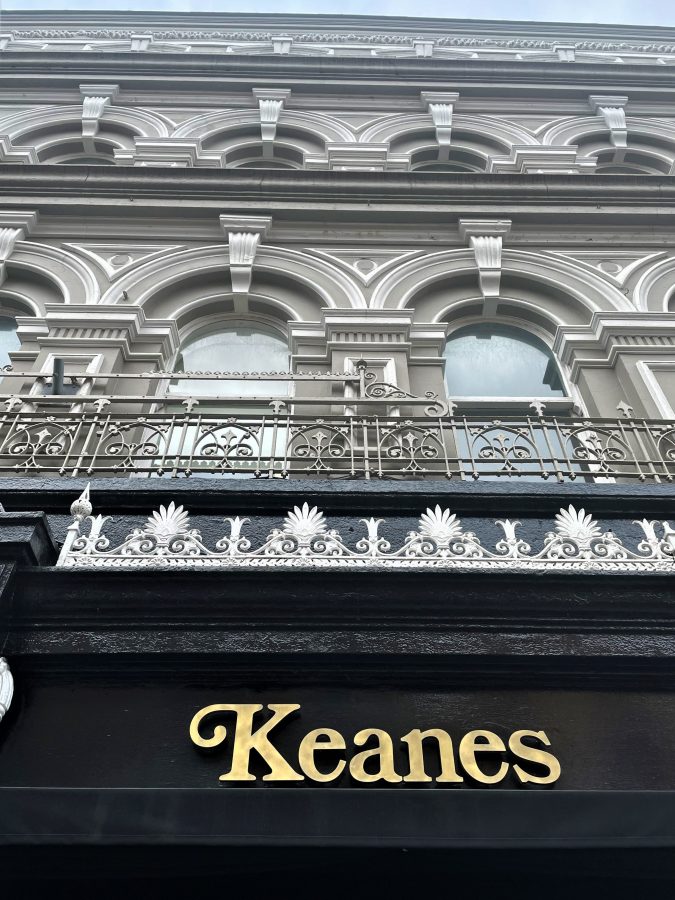
Winthrop Arcade:
The beautiful Winthrop Arcade opened in March 1926. It connects Winthrop Street and Oliver Plunkett Street by a glass covered way and consists of twelve shops. It was the first Arcade constructed in the Irish Free State.
Building on the site commenced in December 1924, and employment was given to local mechanics and artisans since. An article in the Cork Examiner on 8 March 1926 highlights that the materials used in the construction of the shops include marble, mosaic, mahogany, oxidised copper and decolite. The architecture of the structure conforms to the Tudor style. On account of the centralised system of planning adopted, the subdivided overhead charges and general expenses were as far as each particular shop in the arcade was concerned, reduced to a minimum. The types of business which will be carried on are specialised and exclusive, the different proprietors will be enabled to sell their goods at very moderate prices. Due praise was given to Messrs Levie and Chillingworth, architects; John Delany and Son, builders, and to Mr Patrick Crowley, promoter and proprietor.
The first twelve shops that opened in 1926 were diverse in their goods – baby linen specialists (Anthonys), select tailors (Fitzgeralds), grocers, tea and fruit merchants (Bannon Stores), fruiterer (Miss Margaret Murphy), vacant suitable for Fancies, jewellery, etc, tobacconist (Morriss), lingerie specialities (Miss M Griffin), Le Floriste (Collins) Millinery Specialist (Marie). Needle, Craft and Novelties (Emer), Chemist and Druggist (James T O’Sullivan), and Knit-wear goods made in Cork (Mrs Agnes Quinn).
The little altered early twentieth-century shopping arcade retains its distinctive timbered façade and arcaded entrance with shop unit having terrazzo dado wall and curved plate glass façade. Internally, original features such as bronze frame display windows, glazed timber doors and ornate clock survive.
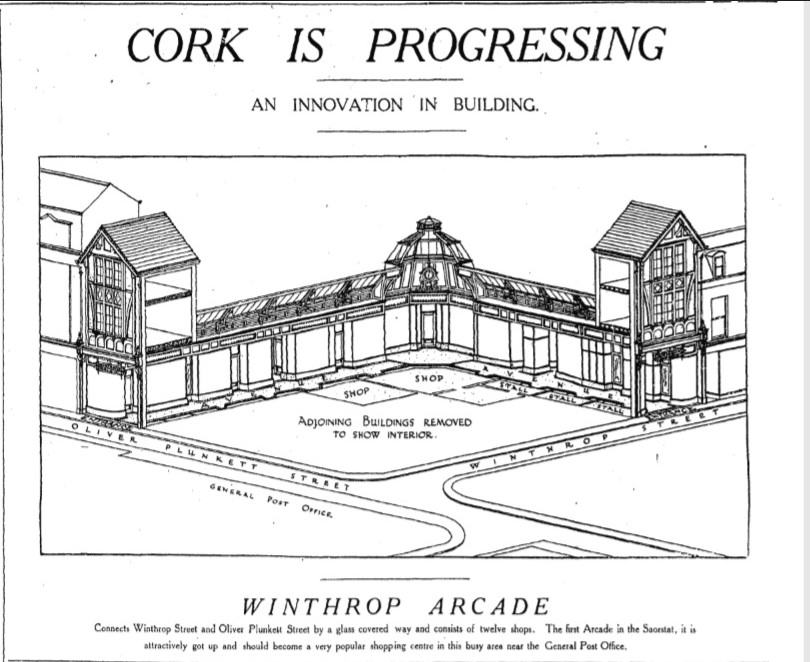
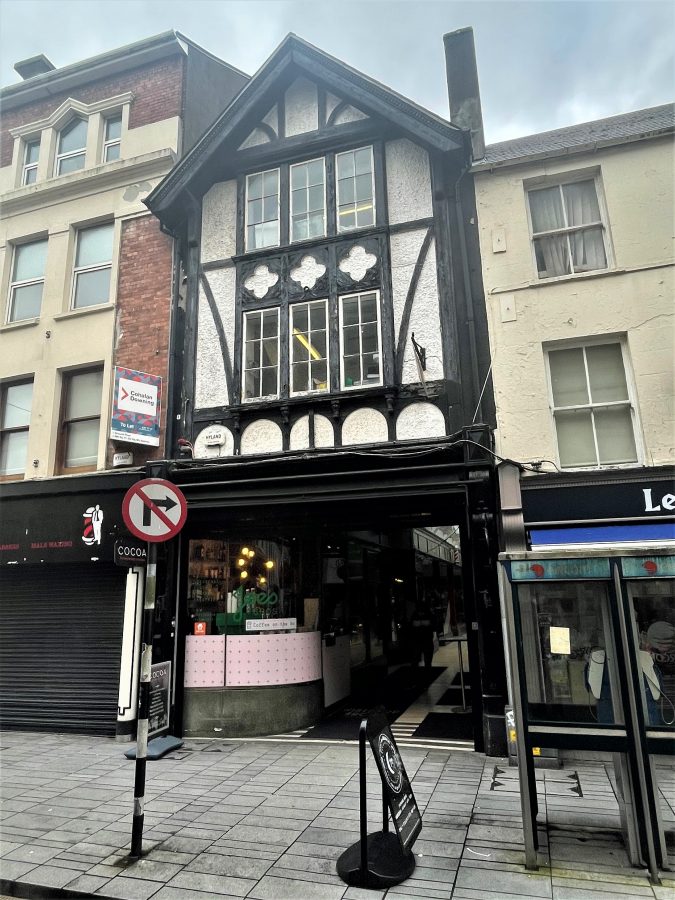

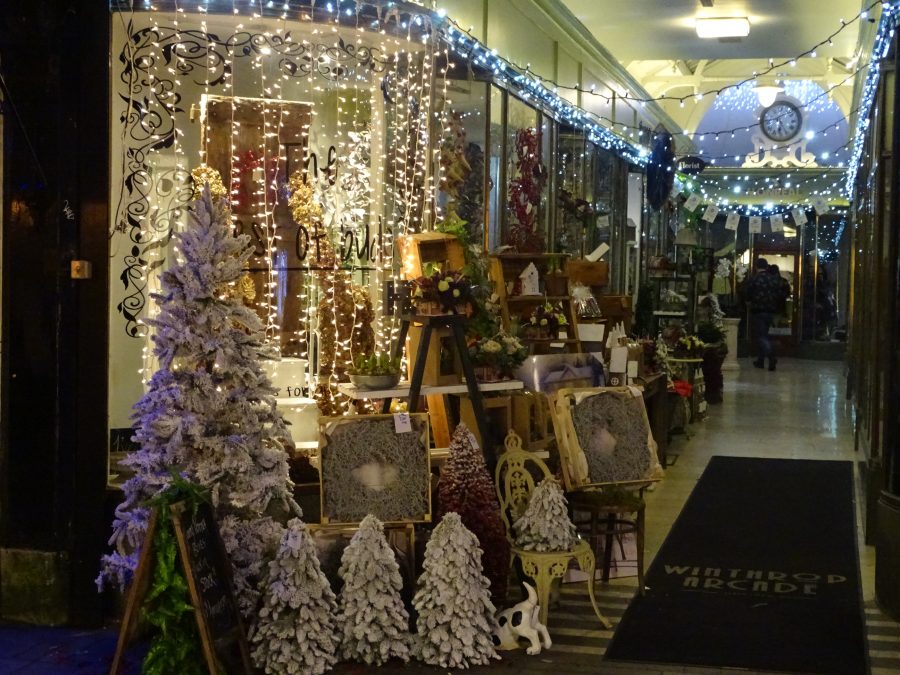
Minihan’s Chemist:
This is a beautiful corner-sited end-of-terrace three-bay four-storey former house, built c. 1810.
From its construction, it hosted the Hibernian Hotel.
The upstairs bar was bought by the O’Donnell family from the early 1920s.
Read more on the Hi-B Bar by Dan Buckley,
Hi-B’s legendary owner part of Cork folklore (irishexaminer.com)
The former hotel now in use retail outlet and public house. Read more about Minihan’s Chemist here: About Us – Minihans.ie

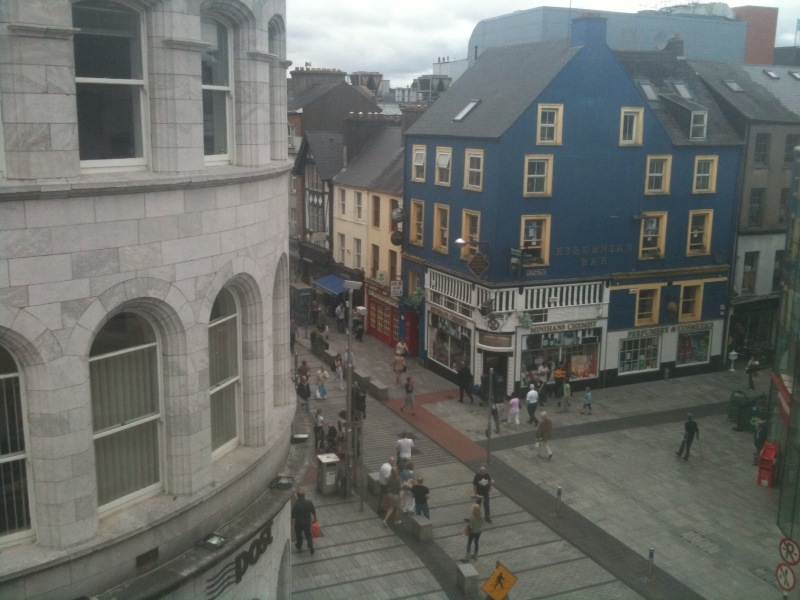

Pembroke Street and GPO:
In 1875, owner, James Scanlan sold the Cork Theatre Royal on Oliver Plunkett Street to the Postal authorities for as part of an elaborate building project for the city’s post and telegraph authorities. Four years later through many plans in early May 1879, a new building opened.
At a cost of £8,000, the building, which still stands comprises limestone, sandstone and cement. It is the design of Mr James Higgins Owens, architect of the Board of Works, his assistant Enoch Trevor Owens, and the contract was carried out by Mr Richard Evans, Cork. The division walls, steps of stairs, arches and floors are made of concretes. It was one of the first buildings in Cork to have concrete as a building material. The building still stands as the General Post Office or GPO for the city.
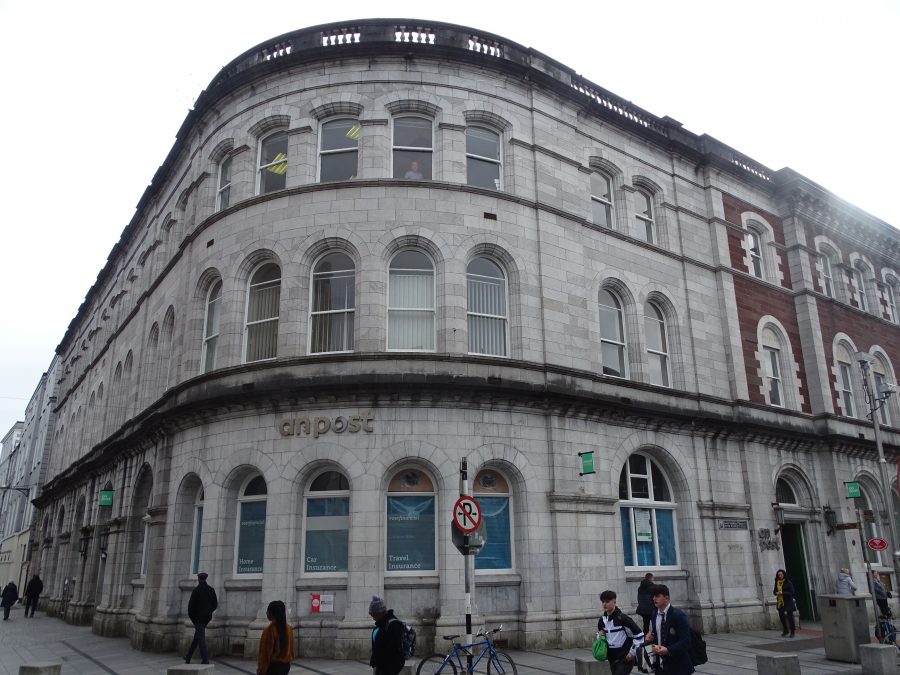
Caroline Street & Cork’s Electrical History:
On Caroline Street is a disused ESB substation, which was built in 1931. The substation was originally used to convert D.C. electricity to A.C. This substation is representative of the design employed by the ESB in the first part of the twentieth century in Ireland.
Initially the supply of electricity to the City was in the hands of the Cork Electric Tramways and Lighting Company, Ltd, who started operations in 1898. The Power House was situated near the River Lee at Albert Road, and also housed the trams at night. A maintenance crew were present if repairs needed to be carried out.
The business of providing electric power grew significantly from 1.8 million units in the year 1900 to 4.9 million units in the year 1916. The connections to the company’s mains for lighting purposes at the end of 1916 were equivalent to 102,000 eight candle power lamps. There was a considerable demand for current for heating and cooking. The electricity supply was ‘direct’ in nature and generated 500 volts to operate the trams that ran through the city’s streets. In about 1925, the name of the company was changed to The Cork Electric Supply Co. Ltd.
Between 1923 and 1929 an Electricity Supply Bill was proposed in order to establish Ireland’s Electricity Supply Board (ESB). The state board was founded on 11 August 1927, focusing on the countrywide distribution of electricity and the promotion of its use. The marketing for the electricity campaign proved successful and in the ten years from 1932 to 1942 the number of the Board’s customers jumped from 77,134 to 200,000. The initial stages of electrification were confined to large towns and large villages.
The ESB annual report for 1929-30 records that following protracted negotiations
agreement was reached with the Cork Electric Supply Co. on the terms of purchase. Formal notice of acquisition was served on the Company on 4 February 1930, and the date of acquisition fixed at 3 April 1930.
The Cork City supply was a D.C. supply from a steam generating station and as the works of Messrs. Henry Ford & Son, Ltd., consumed a large proportion of the supply the Board decided to replace the existing steam station by two new sub stations, one at the centre of the city load in Caroline Street and the other at Ford’s Works.
The Caroline Street sub-station was equipped with three rotary converters, each 2,000 kW capacity. These machines converted the Shannon Arnacrusha Hydro Electric Scheme current which was supplied at 10,000 volts to DC at 460 volts for the supply of the existing city network.
The sub-station at Messrs. Ford’s was equipped with three mercury arc rectifiers, each 2,000 kW, which convert the Shannon current to 500 volts D.C. for the supply to Ford’s plant. In addition, this sub-station contains two Transformers, each 500 kVA for the supply of Messrs. Ford’s furnaces.
The erection of both these stations was commenced in September, 1929. For the connection of these sub-stations to the main Shannon transformer station at Kilbarry, three 10 kV feeder cables were necessary. This work was completed in February, 1930. A temporary supply was thus provided for the Ford Works in February, 1930.

The Caroline Street sub station sat alongside ESB showrooms (now The Oliver Plunkett Bar). At the beginning of the 1931 showrooms were open in Dublin, Limerick, Kilkenny, Tralee, Sligo, Athlone, Wexford, Waterford and Drogheda. In May, 1931, temporary showrooms were opened in Dundalk, and in September, 1931, a permanent showroom in Cork.
District offices were also established in the principal towns. Four of the eight districts, Dublin, Waterford, Portlaoise and Cavan, comprised the Eastern Operation Division and were controlled from the Eastern Operation Office in Dublin. The remaining four districts, Cork, Tralee, Limerick and Galway, constituted the Western Division, and were controlled from the Western Operation Office at Ardnacrusha.
In 1932, the ESB could boast cables running from Ardnacrusha Hydro Electric Station to Cork as well as having the old generating station and offices at Albert Road, the 110 K.V. Station at Kilbarry, a. transformer station at Fords, and the central substation in Caroline Street. The annual consumption of electricity in Cork City was 8 million units by 1934 and 16 million units by 1945.
EXPLORE more on the ESB’s history: ESB Archives | photos, film and stories from the archive at ESB
The National Inventory of Architectural Heritage notes of this building: “This functional building is a well-articulated building, with a high level of architectural design. The building retains many interesting original features and materials, such as the metal casement windows and metal folding doors”.

VIEW: A 1963 Documentary on the story of electricity in Ireland:
Between 2009-2012, Triskel Arts Centre, whilst waiting for the renovation of Christ Church, moved its gallery offsite to the ESB substation on Caroline Street.
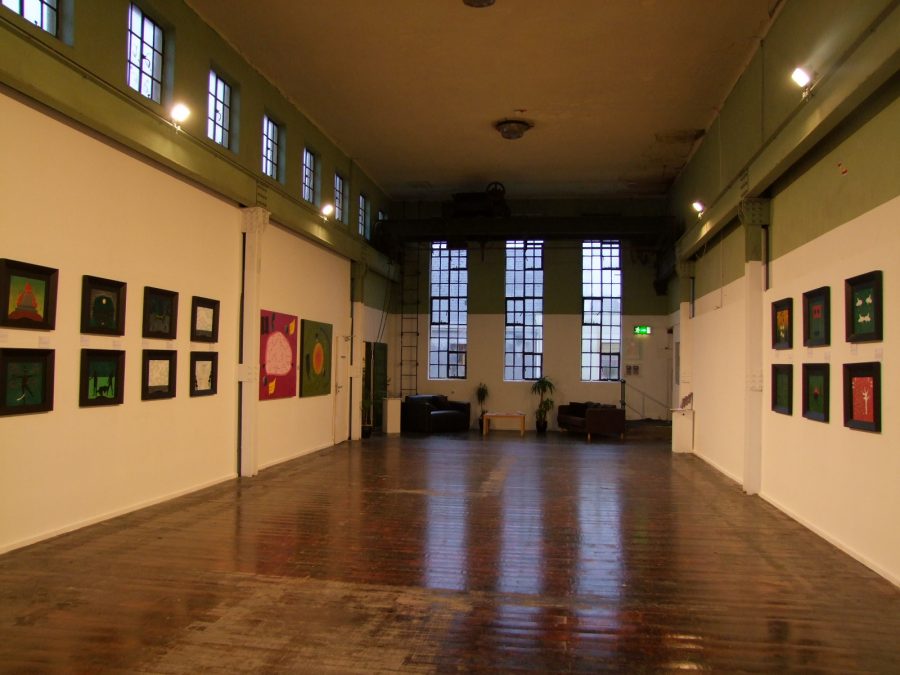
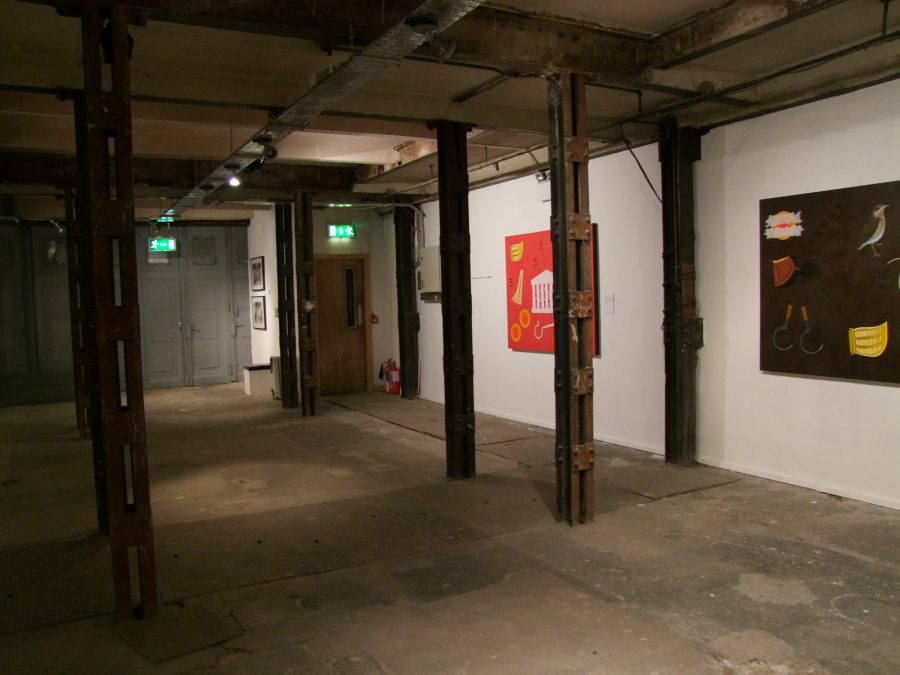
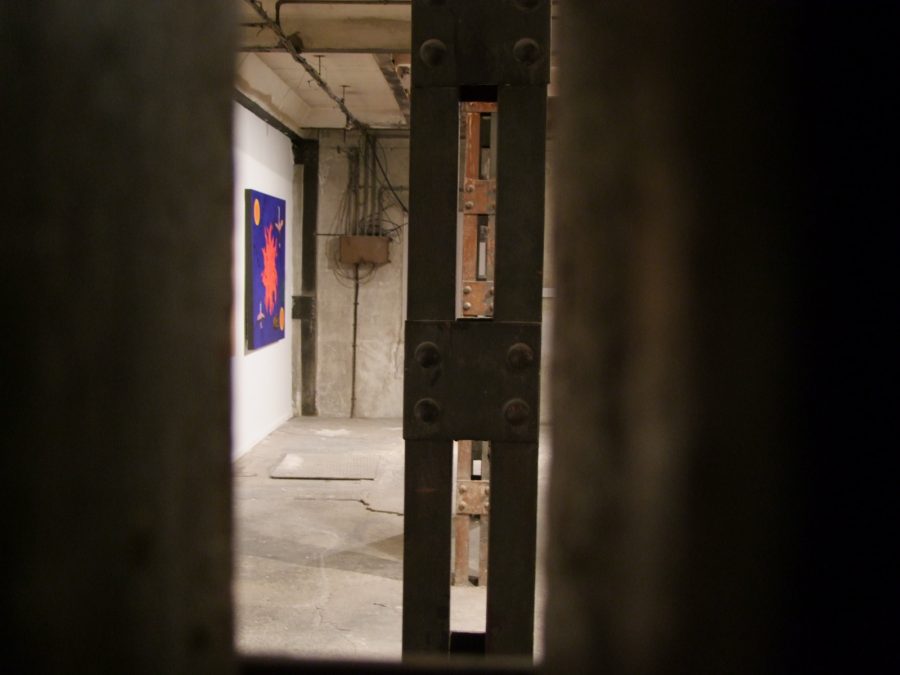
In 2018, Brown Thomas teamed up with Cork City Council and artist Shane O’Driscoll to transform the exterior of the then disused ESB station building which had fallen into disrepair.
READ MORE HERE: Neglected Art Deco building in Cork gets ‘punch of colour’ in stunning makeover, Neglected Art Deco building in Cork gets ‘punch of colour’ in stunning makeover (irishexaminer.com)



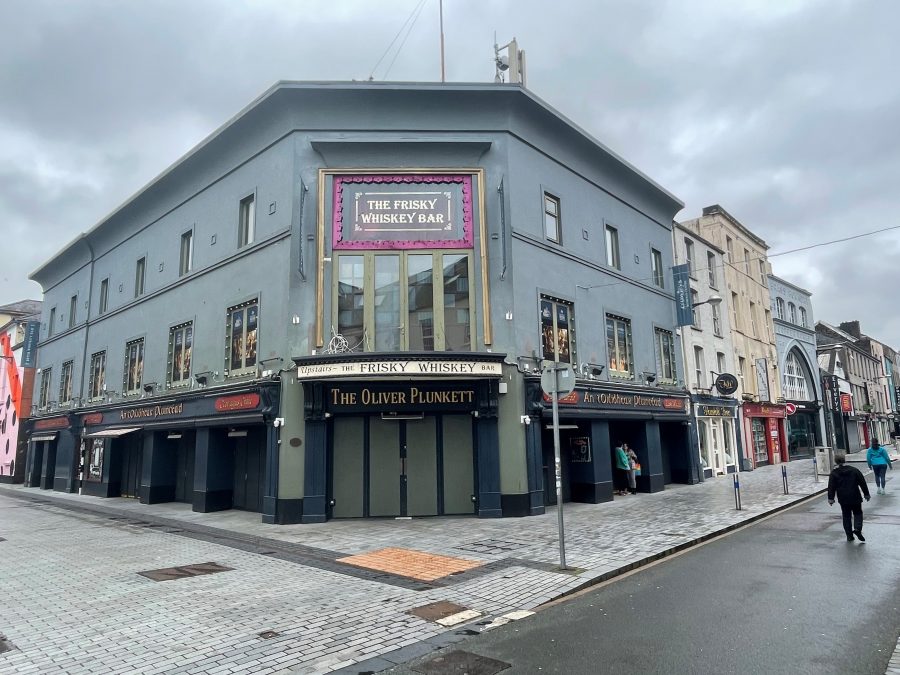
VIEW: The Oliver Plunkett is a lively Cork Bar which brings you the best live music in Cork with gigs on 7 nights a week:
Pulvertaft Brass and Copper Foundry:
In 1844 Robert Pulvertaft, moved his brass foundry from narrow little Tobin Street to Old George’s Street. Circa 1885, a terraced three-bay and impressive three-storey industrial building was constructed.
Until 1942 this business was in and engineering division, where the hands of the Pulvertaft family. In that year the last of the family line Mr Amos William Pulvertaft sold it to Metal Products Limited.
There was little change until 1955. when the foundry was moved from its 111-year-old location in Oliver Plunket Street and given a new, larger and better equipped home on Monahan Road. It was joined there, of course, by the engineering division, the two being almost inseparable.
The move brought benefit all round. As far as the retail and wholesale sales division was affected, it gave ample room to carry to create a new showroom, “custom built” to display to-day’s wares to advantage.
The shift to Monahan Road gave the foundry and engineering division the layout it needed for expansion and smoother production.
The retail shop eventually closed on Oliver Plunkett Street, but now hosts The Athletes Foot shop.
